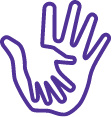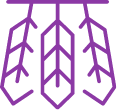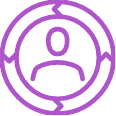Employment
Job Assistance
Resumes
How to Make a Resume
A resume is a written summary of your work, volunteer and educational experience. The purpose of a resume is to show your future employers the skills and experience you can bring to a job.
Resume Building Steps
Make sure you have the information you will need to make it including:
-
Start making your resume
Review your resume, save your document as a PDF, and email it to yourself.
Tips for making a resume
-
- Employers will look at your resume quickly, so get to the point and make it easy to understand.
- Tailor your resume for the job you are applying for. Include skills that will help you be successful in the job you are applying for.
- A 1-page resume is best for entry-level jobs and when you are at the beginning of your career.
- Check your resume for grammar and spelling mistakes.
- Make sure the formatting is the same throughout your resume (eg. same text size and font type, spacing between lines and sections is the same).
- Ask someone to review your resume.
- Use an email address that is easy to read, professional, and non-offensive. For example, firstname.lastname@gmail.com.
- To make your resume easier to read, limit the number of bullet points in each resume section or sub-section to 5-8. This will make it easier for the employer to identify your potential.
- Highlight your achievements by providing specific examples.
Resumes Do's and Don'ts
Resume Do’s
Tailor your resume to suit the position you are applying for
Include work experience or achievements that are related to the job you are applying for. Tip: familiarize yourself with the job posting to gain an understanding of the types of skills and experience that would help make you successful in the job role and include your related expereince.
Highlight what you have accomplished
Use the best examples of where you demonstrated your skills. In these examples, highlight what you accomplished in your role and demonstrate what kind of employee you are.
Be honest
Do not lie on your resume. You have lots of skills and attributes that an employer will value, and they will help you be successful in a job. Also, lying on your resume can backfire. Avoid overstating your skills or results, which will mislead the employer. Try and be confident in what you have to offer.
Quantify your achievements
When possible, use numbers that the employer may be impressed by. For example, how many people you supervised, how many products you sold, etc.
Use simple words and action verbs
Your resume may be read by a recruiter or Human Resource specialist who is not familiar with your field or the language used in your field. Use simple and plain language, with persuasive verbs such as handled, managed, led, developed, increased, accomplished, etc.
Include unpaid work that shows off your skills
Include volunteer work in your resume, especially if it was with a well-known organization, for an important cause or related to the job you are applying for.
Double check and include your contact information
Make sure that your contact information is current and correct, including your name, phone number and email address. This way the employer will be able to reach you for an interview.
Resume Writing Don’ts
Don’t use an inappropriate email address
Use an email address that is easy to read, easy to type, professional and non offensive. An email address that is based off of your name is good. For example, firstname.lastname@gmail.com. Avoid any nicknames, slang, numbers or special characters.
Don’t include unnecessary personal information
Do not include any personal details such as age, weight, height, marital status, religion, political views, or any other personal attributes that may be controversial. This will prevent potential bias against you by the employer/recruiter. Most importantly- do not include your Social Insurance Number on your resume. This number should only be given/used after you get the job, and you are filling out your employment forms, such as your tax forms.
Don’t include a picture of yourself
Including a photo of yourself can lower your chances of obtaining a position and take attention away from your resume. You want the employer/recruiter to focus on your skills and experience, not on what you look like.
Don’t use too many bullet points
To increase readability of your resume, limit the number of bullet points in each resume section or sub-section to 5-8. This will make it easier for the employer to identify your potential.
Don’t use personal pronouns
Do not use “I”, “my”, or “me.” Instead, use statements like: accurately handled cash, debit and credit transactions in a busy retail environment.
Don’t simply list job responsibilities
Highlight your achievements by putting a personal spin on your job duties and providing specific examples.
Don’t make general statements
Personalize your experience and avoid unclear statements that don’t highlight your contribution. Statements such as “Responsible for improving efficiencies and making cost savings” does not provide information about what you actually did.
Don’t include reasons for leaving previous jobs
The main purpose of your resume is to promote you, your skills, experience and achievements. It should be entirely positive, and therefore should not include reasons for leaving, as they do not add value to you as a candidate.
Don’t include references
An employer/recruiter does not need your references unless they are seriously considering hiring you, which usually happens after an interview. Have a separate sheet for your references and provide them to the employer/recruiter only when they are requested.
Don’t include hobbies or interests
In general, avoid including hobbies on your resume unless they relate to the position you are applying for. In this case, including them can help demonstrate why you are a good fit for the position.
Cover Letters
How to Make a Cover Letter
A cover letter is something you write to introduce yourself and tell the employer why they should hire you/why you are a good fit for the job. A cover letter will increase your chance of getting an interview. There is a standard format for a cover letter, and it should not be longer than 1 page. A cover letter includes:
-
- Your contact information (matching your resume).
- The date.
- The name of the hiring manager (or simply put “Hiring Manager” if you cannot find a name), the name of the company, and the company’s address.
- A few sentences for an introduction. Include the position you are applying for and where you found the job posting.
- 1 or more paragraphs highlighting why you are a good fit for the job and company. Include things such as skills, experience, education, shared values, and feel free to let excitement or passion for the job shine through.
- A short closing paragraph.
- Your digital signature (can simply type your name) underneath a pleasant farewell (eg. Sincerely).
Interviews
Steps for a Successful Interview
- If you are one of the final candidates for the job based on your resume and cover letter, the employer/recruiter will contact you for an interview.
- If you accept the interview, you will be given a date, time, and location where your interview will be held.
- Practice for your interview. Practice answering interview questions- the more you practice interviewing, the better you will become. Remember to tailor your answers to the job you are applying for.
- To help tailor your interview answers to the job, research the company and be familiar with the job description of the position you are applying for. This is part of preparing for your interview.
- Choose what you are going to wear for your interview ahead of time. Dress better than you would for a normal day at work if you did get the job.
- On the day of your interview, it is best to arrive 10-15 minutes before your interview is set to begin.
- Introduce yourself to the interviewer when you meet them.
- During the interview, one way to decrease anxiety and nervousness is to remember that the interviewer is a person just like you and the interview is just a conversation between two people. Also, the interviewer chose you as one potential candidate – so that is something to feel good about! They are interested in your experience and what you have to say.
- At the end of the interview, thank them. For example “thank you for your time and the opportunity to interview to become a part of your team.”
- Send the interviewer a thank you email.
- If you don’t receive an update after 5-8 business days, send a follow-up message.
Job Searching
How to Find a Job
There are many ways to search for a job. You can find a job you want to apply for by:










